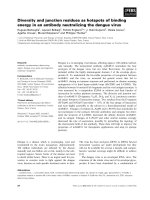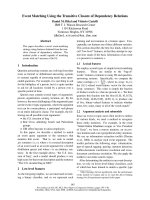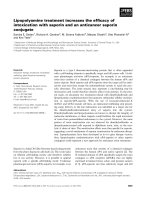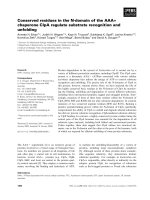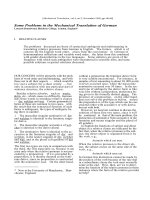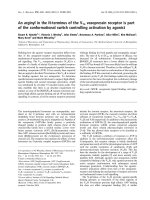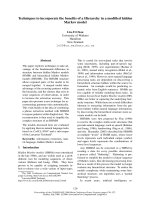Báo cáo khoa học: "Seleno-enzymes and seleno-compounds: the two faces of selenium Xavier Forceville" ppt
Bạn đang xem bản rút gọn của tài liệu. Xem và tải ngay bản đầy đủ của tài liệu tại đây (39.15 KB, 2 trang )
Page 1 of 2
(page number not for citation purposes)
Available online />Abstract
Selenium protects cells and inhibits many inflammatory cell
mechanisms through antioxidant seleno-enzymes. Immunity improve-
ment is illustrated by the study of Berger and colleagues, with
reduction of nosocomial pneumonia in burnt patients under multi-
trace-element supplementation. As seleno-compounds (especially
sodium selenite) are pro-oxidant, however, administration above
800 µg/day may be dangerous in septic shock. Paradoxically,
direct reversible pro-oxidative effects of seleno-compounds may
also be beneficial for reduction of inflammation (genomic action,
apoptosis), and may even be bactericidal or virucidal. These facts
need to be further examined, as well as the possible dramatic drop
of plasma selenoprotein P in septic shock and its role in endo-
thelium protection.
Biological and medical advances in the area of selenium
provide interest in selenium for both its antioxidant properties
through seleno-enzyme incorporation, as illustrated in the
previous issue of Critical Care [1], and its direct pro-oxidant
toxic effect through seleno-compounds.
In intensive care, and especially in septic shock adjunctive
therapy, there is a growing interest in the antioxidant role of
selenium [2-5]. We know that there is a very low level of
selenium in the human (20 mg for the whole body) but that a
severe deficiency is lethal [6]. We also know that selenium
plays a crucial role in antioxidant defense, as one selenium
atom is absolutely required at the active site of all seleno-
enzymes in the form of the 21-amino-acid selenocystein [6,7].
Mammals largely use seleno-enzymes for antioxidant
purposes, whereas bacteria do not. The seleno-enzymes are
ubiquitous in mammal cells and have two main roles. Firstly,
the seleno-enzymes protect cell components against
oxidation: membranes, enzymes, proteins, and DNA.
Secondly, seleno-enzymes inhibit proinflammatory cell
metabolisms by reducing the peroxide tone of intracellular
water (NF-κB, acid arachidonic and complement cascades,
and mitochondria) [6,8]. As a consequence, selenium has
been found to improve immunity [6,7]. In septic shock patients
there is a dramatic and early decrease of the plasma selenium
concentration [9].
In the previous issue of Critical Care, Berger and colleagues
[1] reported the results of a very interesting aggregative study
on a group of 41 severely burnt patients. The authors show a
significant reduction of nosocomial pneumonia by intravenous
multitrace-element supplements (copper, selenium, and zinc).
These results confirm Berger’s research on burnt and trauma
patients conducted since 1986 [4]. This particular population
has lower mortality than septic shock patients [2].
The approach of these studies is to increase the antioxidant
defense by supplementing patients with multimicro-nutrients
(vitamins and trace elements) when there is a dangerous
overproduction of free radicals [4]. In these studies Berger
progressively focused on selenium, and increased the
amount of selenium supplementation. Berger and colleagues,
however, continue to use doses of selenium lower than 1 mg.
For convenience sake, these studies used the easily available
pro-oxidative sodium selenite compound, as have most – if
not all – other studies in intensive care unit patients. But the
question of the compound probably has little importance
when administrated at a level close to the nutritional
800 µg/day no-observed-adverse-effect level for selenium [7].
The two meta-analyses [2,3] tend to conclude that there is a
mortality decrease in septic shock patients when selenium is
administrated at higher doses, but is still less than 1 mg.
There may be another explanation for the efficiency of such
high 1 mg selenium doses, especially when administered
Commentary
Seleno-enzymes and seleno-compounds: the two faces of
selenium
Xavier Forceville
Ch Meaux, Réanimation Polyvalente, 6–8 rue Saint Fiacre, 77104 Meaux, France
Corresponding author: Xavier Forceville,
Published: 13 December 2006 Critical Care 2006, 10:180 (doi:10.1186/cc5109)
This article is online at />© 2006 BioMed Central Ltd
See related research by Berger et al., />NF = nuclear factor.
Page 2 of 2
(page number not for citation purposes)
Critical Care Vol 10 No 6 Forceville
early. In plasma, selenoprotein P – the main form of plasma
selenium – seems to rapidly and dramatically decrease in
septic shock patients [10]. This protein has been described
to protect the endothelium against oxidative stress related to
peroxynitrite in a rat model of diquat intoxication, which may
also be the case in septic shock [10-12]. In fact, the liver
incorporates selenium and may induce a rapid synthesis of
selenoprotein P.
Even though it seems that higher doses of sodium selenite
supplementation are more effective in sepsis, we must
remember that sodium selenite is a pro-oxidant compound.
We must therefore be prudent in administrating sodium
selenite, especially intravenously, in oxidative stress related to
septic shock or similar syndromes, when there is additional
risk of drug interactions [13,14]. In fact, all seleno-
compounds are known to be more or less pro-oxidant
compounds as selenium belongs to the same column of the
periodic table as oxygen [13,15,16]. Acute selenium
intoxication leading to shock and acute respiratory distress
syndromes may be lethal, similar to arsenic poisoning [17].
Paradoxically, the direct pro-oxidative effect of selenium
compounds may be beneficial in septic shock treatment. As
previously stated [10], selenium compounds – especially
sodium selenite – may have a direct inhibition of NF-κB to
DNA binding through a reversible rupture of the disulfide
bridge fixation. Selenium compounds may similarly inhibit
cellular adhesion and even, at higher concentration, induce a
reversible proapoptotic effect, which may help reduce
overactivated phagocytic cells [16]. At even higher
concentrations, seleno-compounds may be bactericidal or
virucidal [15].
Unpublished animal studies support such an interest in
cautious use of very high doses of selenium in sepsis [18]. In
addition, we can note that the studies on septic shock with
the most positive results used a sodium selenite first injection
as a bolus, resulting in a transient peak of blood selenite
concentration [19,20]. The pro-oxidant effect is most probably
transitory due to the rapid incorporation of selenium into the
seleno-enzymes, causing an antioxidant action. At least five
ongoing randomized monocenter or multicenter studies have
differing results, including our sérenité study. These studies
will certainly help us understand the role of dosage and the
method of administration.
Selenoprotein P and selenium compounds, especially sodium
selenite, should therefore be further examined for their
potential interests in the diagnosis and treatment of septic
shock and related syndromes.
Competing interests
XF is the co-inventor of patent FR 98 10889, PCT N°
FR 99/02.66 (delivered: US 6,844,012 B1, Au 760 534;
EP 1107767), the sole inventor of patent US 60 290973,
PCT N° EP 02/05350, and has ownership of the corres-
ponding patents. XF is the sole shareholder of a small start-
up named SÉRÉNITE-Forceville.
References
1. Berger MM, Eggimann P, Heyland DK, Chiolero RL, Revelly J-P,
Day A, Raffoul W, Shenkin A: Reduction of nosocomial pneumo-
nia after major burns by trace element supplementation:
aggregation of two randomised trials. Crit Care 2006, 10:R153.
2. Heyland DK, Dhaliwal R, Suchner U, Berger MM: Antioxidant
nutrients: a systematic review of trace elements and vitamins
in the critically ill patient. Intensive Care Med 2005, 31:327-337.
3. Avenell A, Noble DW, Barr J, Engelhardt T: Selenium supple-
mentation for critically ill adults. Cochrane Database Syst Rev
2004, 4:CD003703.
4. Berger MM: Can oxidative damage be treated nutritionally?
Clin Nutr 2005, 24:172-183.
5. Angstwurm MW, Gaertner R: Practicalities of selenium supple-
mentation in critically ill patients. Curr Opin Clin Nutr Metab
Care 2006, 9:233-238.
6. Rayman MP: The importance of selenium to human health.
Lancet 2000, 356:233-241.
7. Selenium. In Dietary Reference Intakes for Vitamin C, Vitamin E,
Selenium and carotenoids. Edited by Panel on Dietary Antioxi-
dants and Related Compounds, Interpretation and Uses of Dietary
Reference Intakes, Institute of Medicine. Washington, DC:
National Academy of Sciences; 2000:284-324.
8. Forceville X, Vitoux D: Selenium et sepsis. Nutr Clin Metab
1999, 13:177-186.
9. Forceville X, Vitoux D, Gauzit R, Combes A, Lahilaire P, Chappuis
P: Selenium, systemic immune response syndrome, sepsis,
and outcome in critically ill patients [see comments]. Crit Care
Med 1998, 26:1536-1544.
10. Forceville X, Moster V, Vitoux D, Plouvier E, Lahilaire P, Combes
A: Early marked selenoprotein P decrease in severe inflam-
matory and septic patients. In 1st International FESTEM Con-
gress on Trace Elements and Minerals in Medicine and Biology;
May 2001. Venice, Italy: Universita Ca Foscari; 2001:57.
11. Burk RF, Hill KE, Boeglin ME, Ebner FF, Chittum HS: Selenopro-
tein P associates with endothelial cells in rat tissues. His-
tochem Cell Biol 1997, 108:11-15.
12. Forceville X: Selenium and the ‘free’ electron. Selenium – a
trace to be followed in septic or inflammatory ICU patients?
Intensive Care Med 2001, 27:16-18.
13. Olson OE: Selenium toxicity in animals with emphasis on
man. J Am Coll Toxicol 1986, 5:45-69.
14. Berger M: Nutrition of the stressed patient: which place for the
micronutrients? Nutr Clin Métab 1998, 12 (Suppl 1):197S-
209S.
15. Spallholz JE: Free radical generation by selenium compounds
and their prooxidant toxicity. Biomed Environ Sci 1997,
10:260-270.
16. Stewart MS, Spallholz JE, Neldner KH, Pence BC: Selenium
compounds have disparate abilities to impose oxidative
stress and induce apoptosis. Free Radic Biol Med 1999, 26:42-
48.
17. Carter RF: Acute selenium poisoning. Med J Aust 1966, 525-
528.
18. Forceville X, Chancerelle Y, Agay D, Ducros V, Laporte F: At
moderately high level, sodium selenium seems to decrease
mortality in lipopolysaccharide rat model. Intensive Care Med
2004, 30 (Suppl 1):S110.
19. Kuklinski B, Buchner M, Schweder R, Nagel R: Acute pancreatitis
– a ‘free radical disease’. Decrease of lethality by sodium selen-
ite (Na
2
SeO
3
) therapy. Z Gesamte Inn Med 1991, 46:145-149.
20. Zimmermann T, Albrecht S, Kuhne H, Vogelsang U, Grutzmann R,
Kopprasch S: Selenium administration in patients with sepsis
syndrome. A prospective randomized study. Med Klin 1997,
3:3-4.


